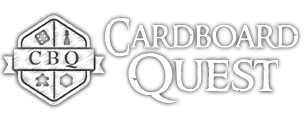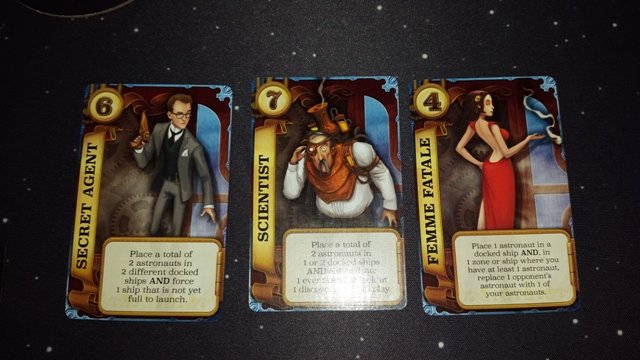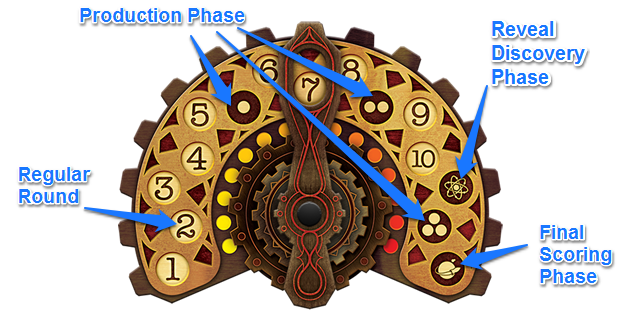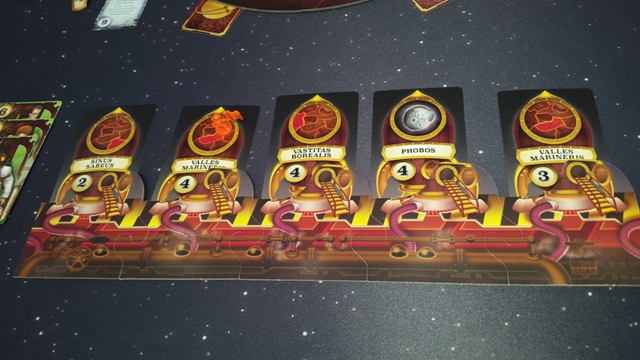Mission: Red Planet Review

What is it?
Mission: Red Planet, a game of humanity’s attempt to save the Earth, yet still turn a tidy profit. This title is the 2005 brainchild of the popular gaming Bruno’s - Cathala (Five Tribes, Shadows over Camelot, Abyss) and Faidutti (Mystery of the Abbey, Citadels). A fine gaming pedigree then, but does this remake improve upon the original?
The year is 1888, and the Earth’s resources are on the wane. Probes report that Mars contains valuable new resources that could save us all. Each player is in charge of their own mining corporation, sent up to the red planet in order to rival each other for control of these valuable ores.
Your goal is to amass the most victory points. These are scored by launching your astronauts to Mars to take control of the various locations and mine their resources (either Celerium, Sylvanite or Ice), and by completing missions. A games consists of 10 rounds, and area-control scoring takes place after specific rounds (5, 8 and 10). Missions are resolved right at the end.
Let’s look at the various phases to give you a better idea of how everything works:
1. Start
Everybody is dealt 2 mission cards, and picks one to keep. These missions are kept secret, and you’ll only reveal these at the end when final scores are tallied. More mission cards (and other types of cards – Discoveries and Actions) can be procured through the game. There is also a universal “Ice Monopoly” mission – the player with the most ice resource tokens at the end of the game scores 9 points.
2. Choose Character
A round starts with each player secretly selecting one of their character cards (marked 1-9). Every player has an identical deck of 9 cards, and each character or “agent” has a unique ability. These cards issue commands, ranging from boarding your astronauts onto the various ship cards, to sabotaging the efforts of your fellow explorers.
3. Resolve Character Effects
The first player initiates a countdown from 9 to 1, with players revealing their chosen cards for that round as they are called out (if multiple players have selected the same numbered card, then the play sequence starts from the current first player, in a clockwise direction). Thus players program a sequence of events, and nobody knows who is playing first or what will happen. Picking high number cards gives you a better chance of playing first, but lower-end cards have great abilities, so pick wisely and perhaps try to anticipate what your opponents are up to. Each ship can only take ‘X’ amount of astronauts, as noted on the card.
4. Land Launched Ships
When the round’s character cards have been shown and abilities played out, any ships that were launched then land on a specific area (noted on the ship itself) on Mars, offloading their astronauts. Astronauts don’t have access to just Mars, there are two additional locations. Phobos, the moon where players can also mine for goods, and then the place where astronauts go to die (be it via assassination or sabotage), the “Lost in Space Memorial”.
If astronauts explore an area for the first time, the type of resource in that area is revealed by flipping the resource token over.
5. End-of-round Maintenance
- Launched ships get replaced by new ship cards for the next round.
- A new first player get assigned (the player who played last by selecting the lowest numbered character card for the previous round).
- Advance the round tracker.
Different Phases
a) Regular Round
The above steps 1-5 occurs on each of these rounds.
b) Production Phase
As previously mentioned, this only takes place after rounds 5, 8 and 10. Any discovered locations (areas containing astronauts) produces resources at the end of these rounds. Round 5 produces one resource token, round 8 produces 2, and round 10 produces 3 resource tokens. Players with the most astronauts in each area, get the resources. If 2 (or more) players have an equal stake in an area, the resources are shared equally (if possible) and any remaining resources are left behind.

Scoring example after first production phase: 1. Orange and Yellow tie, but there is only one resource token that can’t be equally shared. The resource gets left behind. 2. Green edges out Yellow. 3. Only Green is in this area, he get the resource token. 4. Undiscovered area, no resources has been revealed yet.
c) Reveal Discovery Phase
During the game it is possible to place “Discovery Cards” underneath outlying locations on Mars. These cards have interesting effects that will occur at the end of game – like making the affected area produce less resources.
d) Final scoring phase
All points are tallied up from your resource tokens, and completed mission(s).
Think of Mission: Red Planet as Citadels…..
The unfolding of events as the countdown progresses, is the highlight for me. Everybody’s carefully laid plans could (quite literally) go up in smoke as a shuttle is destroyed, or maybe changes course to another location. Astronauts could be assassinated, or enemy reinforcements could be summoned from Phobos (or even from the dead). Expect the unexpected. But where the launch phase flirts with the chaotic…..
….evolving into El Grande
…. the area control aspect takes on a more structured stance. The character cards still dish up their surprises on Mars, but you do feel more in charge of your destiny with the movement of your astronauts, working towards whatever your secret objective(s) are. The set number of rounds eliminates any drawn-out battles to control the various territories (we’re looking at you Risk).
All of this is happening, but amazingly you’re looking at an average game lasting only 45 minutes – time flies when you’re building an interstellar mining monopoly. There is very little downtime (selecting character cards eats up the most time), and each player is genuinely invested in the scheming and movements of others in order to (attempt to) stay one step ahead.
The components are fantastic, from the cartoonish steampunk-themed cardboard pieces, to the fantastic astronaut miniatures. I love details like how the ship cards slide underneath the launchpad pieces to achieve an “attached” look, but that you can slide the ship cards away when launched with the next wave of Mars-miners (insert launch sound effects).
The increased pace towards the end, with fewer rounds to grow your mining activities inbetween production phases, feels masterfully timed. And everywhere you will find tiny mechanics in play to even out the playing field, like picking up additional missions to score more points, or if you’re being squeezed out of the high-earning resource areas you can fight for the Ice Monopoly (9 points!).
BONUS: Major differences between 1st and 2nd edition:
- The minimum and maximum player count has been increased, the original game was for 3-5, but second edition caters for 2-6.
- Mars is now a standalone circular map, consisting of 4 pieces.
- The Astronauts are now miniatures instead of tiny discs.
- New area added, Phobos (which was planned for 1st Ed, and named Utopia)
- The launchpad was redesigned to a new “puzzle-cut” format, to accomodate the amount of players, and the cardboard ships replaced by cards to slide underneath the launchpad.
BONUS Bonus: Soundtrack
Thanks to Stuart we had this great soundtrack for our last M:RP session. It was assembled to listen to while playing Alien Frontier, but it seems to works well with any space-themed title. Alternatively try the Mass Effect soundtracks.

Pros:
Wonderful components
Easy to learn (bordering on light / medium weight)
The fear of the unknown events unfolding! 🙂
Cons:
The fear of the unknown events unfolding! 🙁
Not everybody will love the chaos of the character card phase







